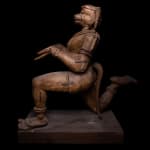17th C, Religious, Orissa-India, Hindu Monkey-God Hanuman in Offering Position, Carved Wood, 17th C, Religious, OrissaIndia, Hindu Monkey-God Hanuman in Offering
17th Century
wood, metal nails
150 x 60 x 120 cm
59 x 23 5/8 x 47 1/4 in
59 x 23 5/8 x 47 1/4 in
1922
Vendu
Plus d'images
The monkey-headed god Hanuman (meaning: "strong man with a broken jaw") is immensely worshipped by the Hindu population. Although his image can be found in temples all over India, he is especially popular in India's northern and central regions. The Indian author, Goswami Tulsidas (16th – beginning 17th C), installed Hanuman statues in the pilgrim city of Banaras. Moreover, Tulsidas wrote as well hymns and prayers dedicated to this god. Hanuman was the son of Anjana and Vayu, god of the wind. As a child, Hanuman was extremely hungry and tried to eat the sun. That infuriated Indra, the god of heaven, storm and war. So, he struck Hanuman with a thunderbolt, which broke his jaw. Then Vayu became enraged and caused life to come to a standstill. To normalize the situation, the various gods of the pantheon decided to give special powers to Hanuman. His strength became legendary. One worshipped him as the protector of evil forces. Hanuman played the role of messenger and servant of Rama, the seventh reincarnation of the god Vishnu. The imposing wooden statue comes from Orissa (or Odisha), a state located in Eastern India. It stresses the enormous strength of the god by showing his very muscular body. His pose, kneeling and holding his hands towards the sky, expresses his respect and adoration for Rama. This fantastic life-size sculpture impresses with its expression. The artist carved the statue on all sides. Such a sculpture played an essential role during Hindu festivals and had to be seen from all sides.
Provenance
French Private CollectionPrivate Collection USA













